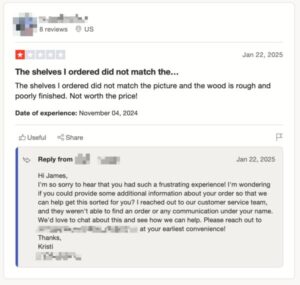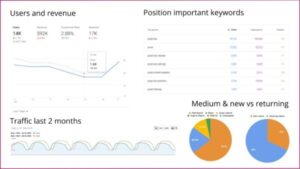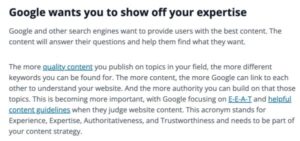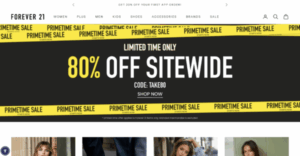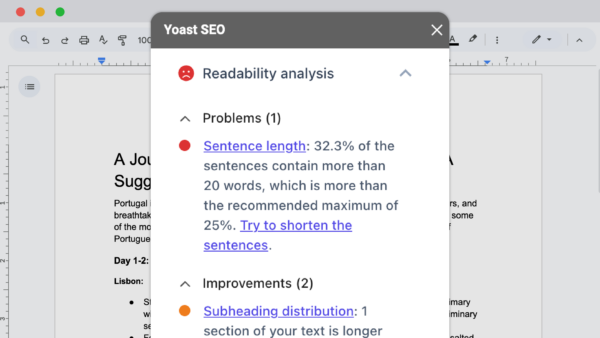
Midway through the year is a good time to see how your SEO is holding up. Search habits shift, rankings change, and AI is reshaping how people find information. A mid-year SEO checkup isn’t about starting over. It’s a check-in to spot what’s working, what’s not, and what to adjust going forward.
Traffic and rankings: What’s changed since January?
Start your mid-year SEO review by checking how your site is performing, not just on the surface level, but deeper down. Look beyond overall traffic and into individual pages and search queries. What’s still working? What’s losing visibility? The goal is to spot slow shifts early, before they turn into bigger problems.
Organic traffic trends
Start with a traffic check in GA4. Compare your organic numbers from January to now, then narrow in on which landing pages have gained or lost ground. After that, use Search Console to see how impressions and clicks line up with the shifts. Look across different devices and locations, as you might notice mobile traffic dropping while desktop stays level.
As you review, think about what’s changed. Are certain types of content sliding? Is the homepage steady while deeper articles get less visibility? Has something in the layout or search results changed how people interact with your site? These patterns will help you figure out where to adjust.
Keyword movement and SERP features
GA4 won’t show you how keywords are doing. For that, use Search Console or Semrush, if you want a more detailed view. It gives you a clearer view of how your top queries are performing and whether their positions are trending up or down. Focus on terms sitting somewhere between positions five and fifteen. These are close to the edge and can shift either way with the smallest change.
Keep an eye out for new queries your site is now appearing for. Also, check if your content is showing up in features like video carousels, People Also Ask, or AI Overviews. These placements affect clicks, even if rankings stay flat.
If CTR is dropping, it might be because the answer’s already visible in the search result. That’s common with broad questions or terms that Google can answer directly with a snippet or summary. Some of these shifts started with recent algorithm updates. If you saw a change around that time, that might explain it.
Being on page one isn’t always enough now. What matters more is how your page shows up and whether it stands out next to everything else.
Where’s the gap?
Ranking alone doesn’t mean a page is performing well. Some are still showing up in search but aren’t pulling their weight anymore. Take a look at your top pages from Q1 and compare them to what’s performing now. If something dropped, check for changes. Did the URL structure shift? Was the copy updated? Did anything break during a migration or redesign?
Segmenting traffic helps spot patterns during your mid-year SEO checkup. Blog content might be holding steady while product pages quietly slip. Or maybe a location page that once performed well is now buried. Sorting traffic this way makes it easier to see where things are improving and where they’ve gone quiet.
And don’t ignore branded versus non-branded search. If branded terms are down, it may reflect lower awareness. If non-branded terms fell off, that usually points to stronger competition or a shift in search demand. Either way, those are signs to act on, not ignore.
What to do next in your mid-year SEO review
As you review performance, note content that’s lost traffic and look at how it aligns with current keyword trends. Some pages may need updates, while others might be better merged or repurposed. If certain pages are still ranking but getting few clicks, flag those, too, as there may be issues with title tags, metadata, or how the content is framed.
Also, look for signs of new search interest or shifts in consumer behavior that are driving unexpected traffic. Those insights can help guide your Q3 and Q4 planning. A detailed mid-year SEO checkup now helps prevent bigger issues later. Small drops or mismatches in intent can add up over time, especially if you miss the early signs. Use your data to make informed decisions, not just to complete a report.
Audit and refresh your content
Not all content holds its value over time. Some pages stop performing due to outdated content, and others never performed well to begin with. A mid-year SEO audit helps you figure out what’s worth updating, combining, or removing altogether.
Focus first on content that’s lost traffic or rankings. Use Google Search Console to spot declines in impressions and clicks, then compare that with GA4 engagement metrics. If a page ranks but no longer drives real value, or doesn’t match what users are looking for, it likely needs attention.
Google wants people-first content. So if your site relies on thin tutorials, vaguely rewritten definitions, or pages written more for search engines than real users, those pages may be dragging down your overall SEO performance.
When refreshing content, lead with clarity. Remove fluff, update stats, and make sure your answer matches the search intent. Don’t just rewrite, make the page genuinely better. In some cases, the fix might be cutting it entirely. If a page hasn’t contributed value or activity recently, rethink why it’s there.
Diversify and focus on video
Search results are more visual than they used to be. Video clips now show up in carousels, featured snippets, and AI responses. If your site is still relying on just blog posts, you’re missing opportunities to be seen.
Short videos, especially how-tos, demos, and explainers, can increase visibility on Google, YouTube, and Discover. They also help with engagement, keeping visitors on your site longer.
Start by turning high-performing articles into videos. Post them to YouTube, embed them on your site, and add basic schema markup. Just a few clear, well-structured videos can increase your presence in search results and help reach users who don’t want to read through long text.
Video doesn’t need to be expensive or overly produced. What matters is that it’s useful, focused, and easy to watch. During your mid-year SEO checkup, you might need to improve your video strategy.
Adapting to AI and zero-click searches
More users are getting answers directly on Google, without clicking anything. With AI Overviews becoming more common across search results, especially for question-based queries, your content needs to work even when there’s no obvious incentive to visit your page.
That means clear structure, clean markup, and highly readable content that makes it easy for Google to understand the core answer quickly. Place key information high on the page and use a strong title, meta description, and subheadings. Organize your content with scannable sections so it’s more likely to appear in featured results.
Don’t ignore FAQ or how-to formats, as these can still help Google identify your page’s purpose. Structured data reinforces clarity for both traditional search and AI-generated summaries.
Zero-click doesn’t mean zero opportunity. Content that’s referenced in AI answers or shown in SERP features can strengthen brand visibility, build trust, and lead to familiar users returning via other channels later.
What AI Mode means for search visibility
In addition to AI Overviews, Google is adding a feature called AI Mode. This is a new search experience built for more complex, multi-part queries. It pulls information from several sources and delivers a conversational response with helpful links.
Instead of listing links, AI Mode breaks down the query, runs multiple related searches, and returns one detailed answer. There’s less space for traditional rankings, but a chance for useful, well-structured content to be included. If your impressions are rising but clicks aren’t, your content may already appear in these summaries.
While AI Mode is still rolling out, it shows where search is likely headed. And it’s not just Google, as tools like ChatGPT (Search) and Perplexity show that AI-powered discovery is already expanding. As this grows, you might have to rethink how you see content. Learn how to optimize for LLMs using Yoast SEO’s tools.
Refresh your keyword strategy
Midway through the year is a good time to check if your keyword strategy still aligns with how people are searching. Start with Search Console and any SEO tools you use, and look for shifts in rankings, drops in CTR, or signs that user intent has changed. Some keywords may still rank but deliver less value, while others may be gaining traction.
Take another look at the SERPs. Are AI Overviews, snippets, or video results pushing your links down? If your content no longer fits the query, it may need a rewrite or a new format.
Also consider what’s surfaced since Q1. Seasonal queries, comparison searches, and longer questions might now be worth targeting. Even if they bring less volume, they often convert better. Use what you find to adjust your focus for the second half of the year.
Technical SEO clean up
Great content alone isn’t enough if your site’s technical side is holding it back. A mid-year SEO checkup is a good time to inspect the foundation. See how your site loads, how it’s crawled, and whether pages are being properly indexed.
Start with speed. Use Google’s Core Web Vitals tools to review page load performance. Fix common issues like oversized images, unnecessary scripts, or layout shifts that hurt usability. These things don’t just impact rankings; they also affect how users experience your site, especially on mobile.
Look at crawlability. Search Console can show you which pages aren’t being indexed, where crawl issues are popping up, or if valid content is being skipped. If strong content still isn’t performing, this could be why.
In your mid-year SEO checkup, you should also see your internal linking. Important pages should be easy to reach. If key articles or landing pages are buried under layers of clicks or orphaned entirely, Google’s crawlers (and readers) may never find them.
Finally, check out your structured data. Schema still gives your content a better chance of being understood by search engines.
A light technical review every few months helps keep things healthy. You don’t need to fix everything at once, but leaving small issues unsolved can turn into long-term performance headaches.
Monitor competitors and trends
Search isn’t static, and neither are your competitors. Even if your strategy hasn’t changed much since Q1, theirs might have. A mid-year SEO checkup is a smart idea to see who’s gaining ground, what kind of content is outperforming yours, and what shifts are happening in your space as a whole.
Start by checking who’s around you in the search results, especially for your highest-value keywords. Are the same domains showing up? Has a competitor overtaken you with fresher content, a better format, or a new angle? Sometimes it’s less about Google’s algorithm and more about someone else simply doing it better.
Use ranking and backlink tools to identify newer content that’s climbing. What’s different? Is it shorter, clearer, or more visual? Has it earned links or been widely shared? These observations can shape not just what you publish next, but how you structure and present it.
Whether you’re in an aggressive or stable position, awareness is part of strategy. Without reviewing what others are doing, you don’t have a clear view of what winning looks like right now or how quickly that picture is changing.
Set clear goals for the rest of the year
After reviewing performance, updating content, tightening technical issues, and refreshing keywords, the next step in your mid-year SEO checkup is setting focused goals for the rest of the year.
Keep them specific. A goal like “get more traffic” is too vague to drive clear action. Use what you’ve learned, whether that’s from rankings, audit results, or crawl reports, to define outcomes that are tied to your time, resources, and business needs.
Look for low-effort wins and long-term improvements. Fix pages that rank but don’t get clicks. Update content that dropped after an algorithm change. Strengthen internal links to help strong posts on the edge of page one move up. These small changes can improve results with less time than starting from scratch.
If AI features are reducing your traffic on top queries, consider focusing more on visibility than clicks. That might mean leaning into content formats that stand out in summaries, like FAQs or short-form video.
You can also set process goals: publish more consistently (maybe using workflow improvements from Yoast SEO’s Google Docs add-on), clean up old content, reduce crawl waste, or make reporting easier. These are just as important as traffic-focused targets, and they’re often easier to maintain over time.
Your goals don’t need to be dramatic. Often, refining what already exists brings more gains than chasing something new. Revisit your targets regularly and track your progress without overthinking it. Most importantly, stay flexible heading into Q4, when search activity and competition both tend to spike.
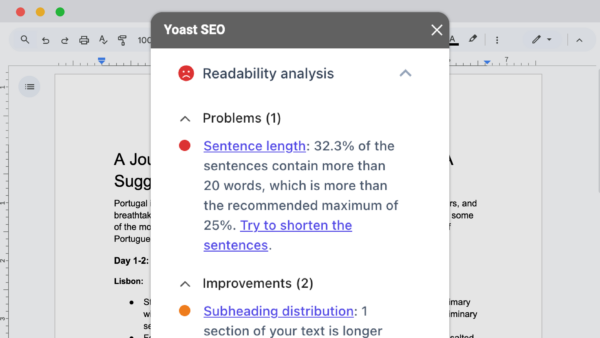
Do your mid-year SEO checkup
Search has changed a lot since January, and it’s not slowing down. A mid-year SEO strategy review gives you the chance to course-correct, refocus your efforts, and keep momentum going into the back half of the year.
You don’t need to overhaul everything. Just fix what’s broken, improve what matters, and make better decisions with what you know now. Stay consistent, track what shifts, and keep building.
The post Mid-year SEO checkup: What’s working, what’s not? appeared first on Yoast.


